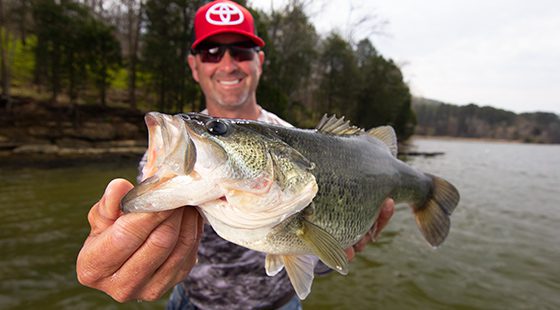Cast a Rapala® DT®-20 upriver and bang bottom across a hump in deep water and you’re bound to catch a lot of big bass the next few weeks on Lake Guntersville and similar reservoirs across the Southeast.
“You can go out and catch 22 to 25 pounds every evening in a couple hours, and catch 90 percent of them on the DT-20,” says Bassmaster Elite pro Gerald Swindle, who lives on Lake Guntersville. “It’s been the DT-20 Summer around the Swindle house.”
Swindle’s fishing buddies are on an epic DT-20 bite too.
“There’s a running joke with the four or five guys that I fish with that there ain’t a tackle store within 60 miles from here that’s got a DT-20 left, ‘cause we bought every one they had,” Swindle says. “They’re bitin’ it, so we’re givin’ it to ‘em!”
“DT” stands for “Dives To.” Built of balsa wood, Rapala’s signature material, a DT-20 will get down to its maximum depth of 20 feet sooner than – and thus stay in the strike zone longer than – lookalike crankbaits. The way its balsa body wobbles while swimming and digging its bill into the bottom make it the perfect tool for triggering bites from bass in their deep-water summer haunts.
“All around Guntersville, the bass are in their peak-of-the-summertime patterns,” Swindle says. “The fish are really out there good in the 15- to 22-foot range, which is where the DT-20 excels.”
Go head to head with Swindle by throwing lookalike crankbaits and you’ll see just how well a DT-20 excels. “I went out with some guys and they wanted to stand toe-toe-and throw some other baits, but you just beat the britches off ‘em with a DT-20,” Swindle says. “And they’re like, ‘We don’t get it!’ But fish have the tendency to desire different baits at different times, based on whatever’s different with the baitfish they eat. This summer, the bass are feeding on a lot smaller gizzard shad, I think. I’ve seen a lot of shad around 3 or 4 inches.”
That’s why bass are ignoring bigger and louder deep-running crankbaits, Swindle surmises. “The DT-20 has a really good shad profile, but it’s not as big and gaudy as some other baits,” he says. “The sound’s not as obnoxious and it really does match the shad they’re eating.”
To catch deep-dwelling reservoir bass this summer like Swindle does, spool up a Disco Shad-colored DT-20 on 10- or 12-pound-test fluorocarbon line on a 5.3:1 baitcasting reel and 7½-foot baitcasting rod and follow these tips.
First, use your sonar/GPS unit to locate a few hard-bottom humps or high spots in otherwise deep water, “where it comes out of like 40 feet, up to 20, and back down to 40,” Swindle advises.
When you see fish on your sonar screen in such areas, move back downstream a bit and set your electric trolling motor to its virtual-anchor setting. Cast your DT-20 upstream past the hard-bottom hump and retrieve it fast and hard. “Boat position is key,” Swindle advises. “Whether I’m at Guntersville or any reservoir when the current’s moving, I want to crank my bait with the current to get that natural presentation.”
You’ll catch more fish if you reel your DT-20 fast, grinding it into the hard bottom across the entire distance of the hump. “It’s key that you make bottom contact,” Swindle says. “90 percent of the bites will come on the bottom. So a key for me is burning it to get it down. But once I get that bait down on the bottom, I don’t slow up on it, I keep bringin’ it. I’m reeling it like I’m having a fit, reeling it so fast.”
A Rapala DT-20 gets down to the strike-zone fast with the help of a metal disk permanently embedded in its ultra-thin polycarbonate lip. Swimming with a side-to-side action only balsa crankbaits can achieve, DT-20’s pull with ease despite the depth to which they dive. Perfectly weighted to hit the water in a nose-down, quick-dive position, they can be easily cast 150 feet.

“The DT-20, out of everything I’ve tried, has dominated the amount of bites I get when the bass get out deep in the summer like this, no matter if it’s windy or slick,” Swindle says. “It’s just subtle enough you can throw it in most all conditions, but yet aggressive enough when they are feeding it will catch every giant in there. And that’s hard to find in anybody’s crankbait, not just ours.”
DT-20’s measure 2 ¾ inches, weigh 7/8 oz. and come armed with two No. 3 black-nickel VMC® trebles. They feature a specially tuned internal baritone rattle, premiere finishes in all the right color patterns to match local baitfish across the country.
Disco Shad, an Ike’s Custom Color, is Swindle’s “number-one color, day in and day out” for targeting deep summer bass with a DT-20. “It’s a great imitation of the gizzard shad that they’re feeding on and it looks really good in that color of water,” he explains. Blue Back Herring has also been productive for him.
Swindle’s last bit of advice for replicating his successful summertime DT-20 bite is to cycle through several different humps where you’ve marked fish. Be patient and persistent on each one. If your electronics show a school, those bass are likely to bite as soon as you bring the bait past them at the right angle.
“You might have to throw 15 or 20 times,” Swindle advises, “but all of a sudden, one will bite it. And when one bites it, buddy you can just wreck ‘em for the next ten minutes – just really catch ‘em!”

